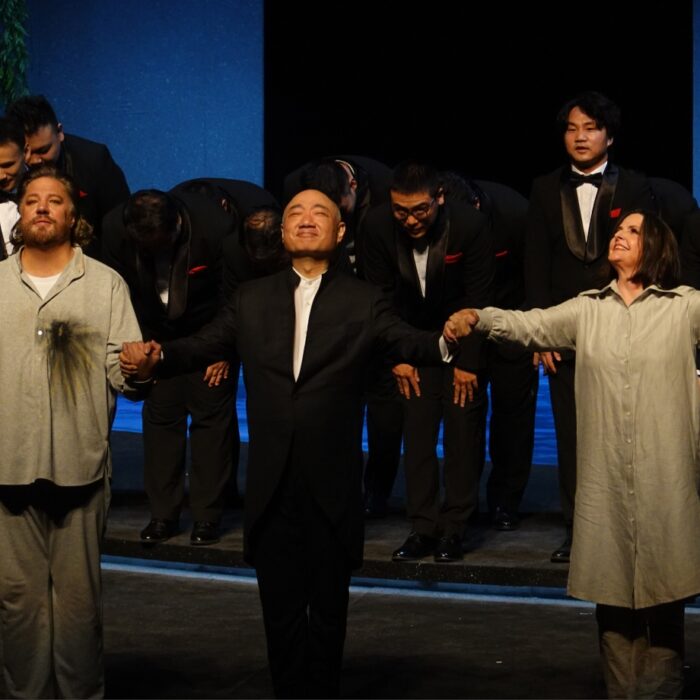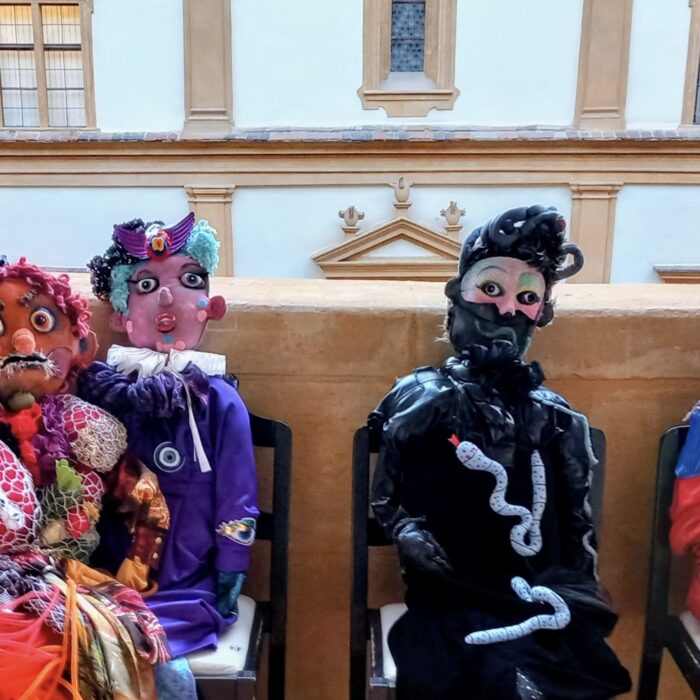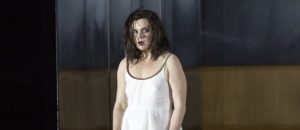
Salzburg Festival 2020 Review: Elektra
Aušrinė Stundytė & Asmik Grigorian Shine As Audience Trapped by ‘Charged Puma’ of Strauss’ Vibrant Masterwork
By Ona Jarmalavičiūtė(Credit: Salzburg Festival / Bernd Uhlig)
Entering the dark Felsenreitschule hall of the Salzburg Festival, carved into the rock of a mountain, you feel uncomfortably crammed inside the mountain – in a terribly unfamiliar space that hides something in the distance of the stage. So far you can’t see or hear anything but in the air, you feel uncertainty, tension, threat.
The owner of the territory is a predatory and ruthless beast. At the beginning of the action, the sharp eyes of the mythical Elektra shine at the end of the cave.
The Puma
According to soprano Ausrinde Stundytė’s interpretation, the black puma Elektra is piercing her prey with her eyes – the audience. The predatory eyes reflect the poisonous personality of Elektra, blending fierce hatred with bitter cynicism, acid jealousy, and tasteless emptiness. Organically united with R. Strauss’ s fierce music, which is no less threatening, this opera becomes a real predator, threatening to inject its teeth into the audience in an instant.
The symphony orchestra reflects the depth of the heroine invisible on the outside. A powerful, frantic, and elusive sound, moving with a huge whim, creating and rippling along with Elektra’s breathing, heartbeats, and movements, opens up the alternating inner states of Electric.
R. Strauss sails where the restless, chaotic, and painful world of the character leads. Elektra unites with it. This common force, reminiscent of an electrified puma, does not let a tense listener out of its jaws for a moment. The listener cannot escape – even with closes eyes, one feels as if attacked and overwhelmed by this intense sound, which mercilessly pulls, jumps, and frightens one in the chair.
The puma of R. Strauss’s music on this night was painted by the hands of conductor Franz Welser-Möst. It is in this form that he revived an ancient myth of which he was afraid of losing control.
According to the conductor, strong self-restraint is needed to capture the total pulse of the composer and the orchestra and to maintain it in a constantly uneven rhythm rippling between dynamic extremes. The soloists, working with Franz Welser-Möst, collectively testified to this musical alchemist by mastering the mystery of R. Strauss’s music.
It is said that the conductor together with the Vienna Philharmonic Orchestra, knows how to shell out the leitmotif system and encrypt the hidden meanings that R. Strauss’s music gives to the characters and their experiences. During the performance, the conductor’s face was sometimes reflected in flashes on the walls of the red glass room, testifying to the his masterful movements and actions.
A Tragic Constellation
The tragic constellation of the family was staged by Polish director Krzysztof Warlikowski, who stands out for his ability to understand, feel the psychological connections between the characters, and aesthetically convey extremes.
The director mentioned that in each century the Myth of Elektra is imitated again and in the 20th century it has become the embodiment of psychological extremism. While composing the music for “Elektra,” R. Strauss experienced a personal family tragedy – when his father died, he saw his mother psychologically shattered.
The myth of Elektra brought to the surface his fears about complex and ambiguous family relationships – these settled in every beat of the opera he was composing at the time. The ancient gods acting in this way become ordinary people dependent on the uncontrolled psyche and irrational obsessions. As a result, “Elektra” also foretells discoveries in the field of psychoanalysis – as early as 1913, on the basis of this antiquity, the Elektra complex (the female equivalent of the Oedipus complex) was formed, based on Z. Freud’s insights into toxic repressed passions in family relationships.
Not surprisingly, due to the angle and personality of the new approach, listeners today are shocked by the naked, uncontrolled expression of emotion that contrasts with what the viewer often does not want to see.
Taking advantage of this, Krzysztof Warlikowski told the multi-layered and psychologically stressful story of the Atreus family. This includes two generations and five members intertwined with threads of life and death, love and hate. Each of them drowns in their personal tragedies, losing their minds, identities, and lives along the way. In this production, the interpretations of these pain-stricken family members are more human, and on an emotional level, each of them is very sensitive. Hysteria, confusion, and self-destruction are experienced on stage along with the characters. Following in the footsteps of hot and sticky revenge, the family kills themselves in the opera finale.
At the heart of the tragedy is Elektra. An extreme character entrusted to Lithuanian Aušrinė Stundytė, who focuses on twentieth-century music repertoire. The singer has stated that she feels intimate with the character, perceiving her as a broken sobering soul.
The rougher timbre of the soprano created an incredibly expressive and assured vocal interpretation of Elektra. The Lithuanian artist was able to manage all the requirements for this role’s intensity and bring even more energy to the stage than might be expected.
She herself has claimed to be too “respectful of the stage and the audience to offer them less than she can give.” The boundless stage and voice expression convinced everyone who listened to this.
Stundytė Elektra was more feminine and more vulnerable than in previous interpretations of this role. Since Elektra’s character is determined by her sense of justice and boundless love for her father, Stundytė was first portraying her as a girl who saw her mother kill her father as a child.
As a result, Director Krzysztof Warlikowski began the opera with a new prologue – surrounded by cicadas chirping and followed by the sharp Elektra as she eyes her mother Klytämnestra confess to the murder. When Elektra listens to her mother’s monologue, the desire for life in her eyes is changed by emptiness and a wound that never heals opens. It becomes clear as the circle of revenge sets in, condemning her and all around her to destruction.
So, pre-programmed by parental relationships, losses, and bullying, Elektra is born. Mourning and revenge become her only consolation.
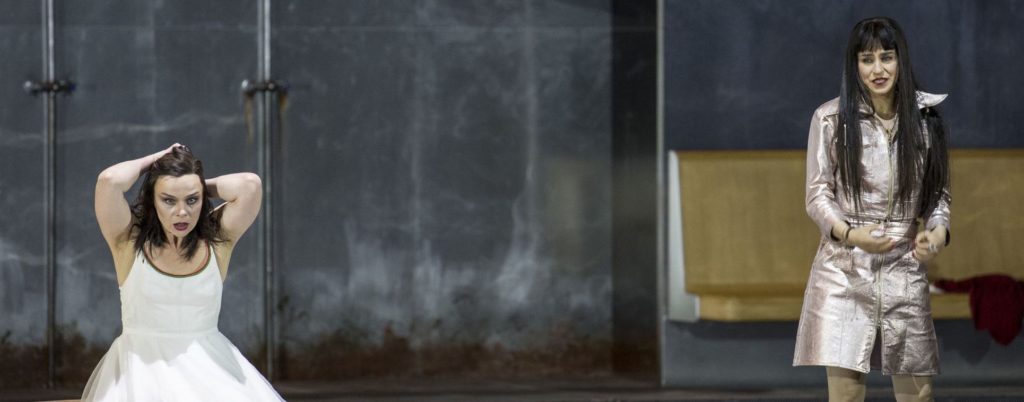
(Credit: Salzburg Festival / Bernd Uhlig)
The Puma’s Opposite
Returning to the Salzburg Festival for the fourth time, another Lithuanian soprano Asmik Grigorian became the opposite of Elektra – her younger sister Chrysothemis, who is living with hope. The transparent and resounding triumphant voice of Grigorian perfectly revealed the character’s faith in the future.
Appearing on stage with red heels and a pink disco costume, Chrysothemis creates the image of a confident, open woman. She allows herself more feminine emotions than Elektra and dreams of the joy of life after having children.
However, while better hiding it from himself, Chrysothemis is the same injured and traumatized member of the Arteus family as the others. At the end of the opera, she remains alone. Concluding the opera with two repetitive screams Chrysothemis summoned by her brother, the truth opens before her eyes that the exterior of strong femininity she has formed can no longer protect her from what she is feeling now.
Day Night, Sun Moon, Life Death, Elektra and Chrysothemis. These two are sisters antonyms. When a family is hit by a tragedy, they find themselves on different sides of the same coin.
The elder Elektra’s world does not reach the sunlight of life – the only comfort she finds in fantasies about her mother’s and her own death.
The younger Chrysothemis cannot understand and appreciate this. They do not communicate, as night never merges with day, and a living person cannot understand death. Sung together by two Lithuanians further reflects this paradox – a sister commonality of the tragedy that unites them and at the same time a sharp difference in their perceptions of life.
The Dividers
However, the main conflict in the opera is fulfilled with the appearance of a third person – the mother of the two, Klytämnestra. The family triangle, woven with love and hate, was completed by a painfully human fear-driven character created by German mezzo-soprano Tanja Baumgartner.
The performer perfectly combined singing with acting – in the monologue of the beginning of the opera, when she justifies the murder of her husband, the viewer was allowed to understand the roots of this family’s tragedy more deeply.
Brother Orest, performed by Australian bass-baritone Derek Welton, imprisoned in his grandmother’s knitted sweater, has a hard time choosing which family member’s angle to choose from in the triangle. His interpretation as a deeply confused and sensual person was also more complicated than usual. He sees women in three different positions being interdependent. It is only through their interaction that their identities are formed, and this tension stirs the action on stage.
The music of R. Strauss, which accompanies the development of all these relations, does not even try to explain or simplify the interaction of different family members. The sound only exacerbates their depth, paradox, and complexity. From the beginning, enslaved by tragic circumstances, their lives seem long overdue.
However, the path from the end of life to death, which called for the murder of Klytämnestra and the suicide of Elektra, is arranged on stage in three spaces – a room of red glass in the murder room-container; in the sofa where Elektra commits suicide; and the murder of his father in a pool of water where he sometimes, as if a ghost from Hamlet, appears with a bloody head carved in, to see his daughter again.
A fourth space and time are formed by projections on a cold Felsenreischule rock. Elektra remembers the cruel childhood memories that haunt her, these are simultaneously staged in a red room and broadcast in colorless projections. In this way the listener is brought even closer to the inner world of the character; linked to its past, present, and future. With this tool, the director allows the undiscovered meanings of the ancient myth to be revealed and thus creates a deeper dramatic experience.
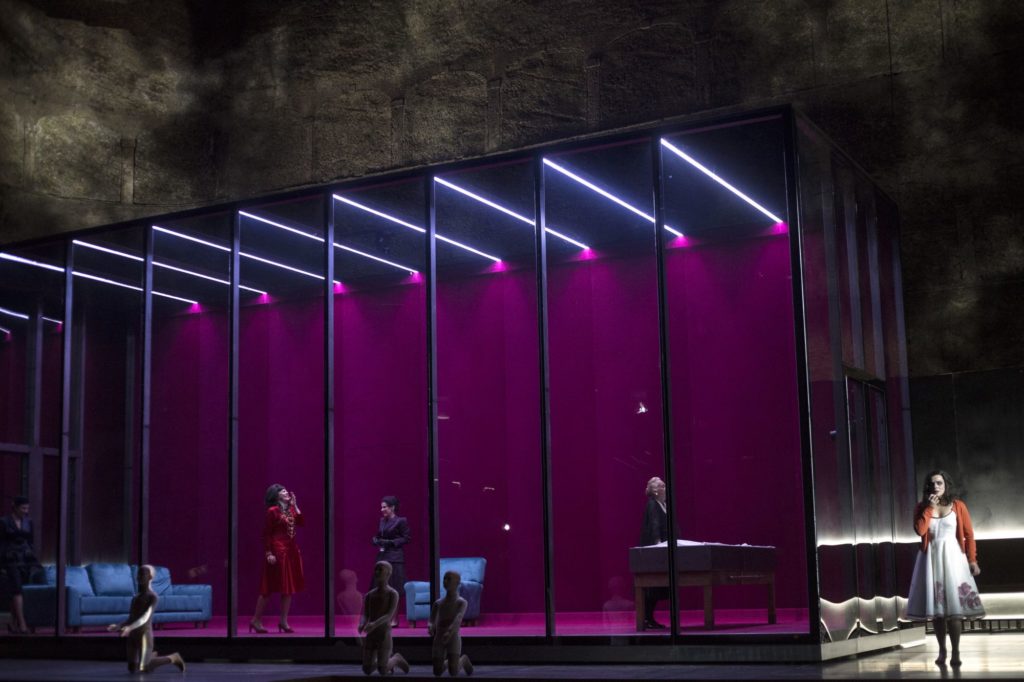
(Credit: Salzburg Festival / Bernd Uhlig)
Chewed Out
Due to the different spaces, the scene seemed inconsistent and crowded at first glance, but when the action began, its organic quality and persuasiveness were felt, giving the action more integrity and meaning. Some of the most striking elements were colors of blood and grief, as of death artifacts recurring in scenography and costumes.
The clothes of the characters, like their musical psychological interpretations, were scenic, but more mundane and life-like than might be expected in an opera. Three black-haired women presented red details in their clothes – Elektra wears a red jacket and a red flower ring in the folds of the dress. Chrysothemis wears red lipstick, red heels, and a red bra. Klytämnestra is wearing a bright red dress with colorful matching necklaces. It is these recurring colors that ultimately combine all the scenographic elements into a whole that is visually stylish, unadorned, yet extraordinarily expressive and helps the characters to fully unfold.
The color palette is established in the scenography during the murder of the mother Klytämnestra when the tension grown during the whole opera breaks down. The red room suddenly blindly darkens and turns black. Despite the fact that, according to the rules of the ancient theater, death is not visible, it is heard – a coarse scream pierces the puma cave.
The eyes of an electric predator flash when she turns to the audience excited and incites the beast: “stab again!” The predator attacks and at that moment the breathing of all the listeners probably stops. The puma injects its teeth into the bone marrow.
The music for a moment does not allow the listener to inhale again, moving at an elusive speed, in unpredictable directions. The second prick is the mother’s faint moaning in the dark, with the mountain rock flooding with blood and disturbing flies appearing, creating a black and red spree on the gray stone walls.
When the black puma finishes his work, all that is left of the action scene is blood scores and razors.
The death of the mother does not suppress Elektra’s dependence on death and this time she chooses to commit suicide herself. But during the suicide scene, she’s happy.
“Love kills everyone, but no one leaves this world without knowing love,” are her words, the last reverence to her father.
Despite anything, it was a moment of her dream come true. If only we had something to say about death, we might even believe in suicide in finding its fullness and peace. Hope also does not give up young Chrysothemis – she admits to hearing a circle of revenge by closing to reconciliation.
After killing his mother with his own hands, Brother Orest breaks away and escapes steeply from the stage, interfering with the audience. Seeing the panic in his face and movements, it becomes clear that this is how he is trying to escape from himself. The heroine of Grigorian remains alone in the dead house and the lights dim completely, relentlessly silencing the further fate of this character.
The audience did not release the black puma from the mountain for a long time, challenging R. Strauss himself with the intensity of their applause. After being chewed and spit out, people walked the western streets of Salzburg, celebrating their first opera after half a year.
